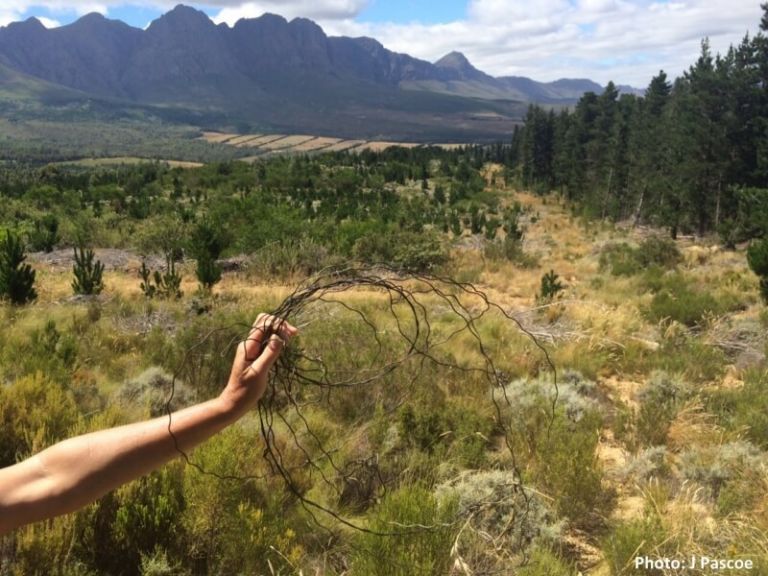Our conservation partner, CapeNature, was recently called to assist a leopard caught in an illegal wire snare in the Paardeberg area. The leopard's plight was fortunately highlighted by a local farmer before any major injury to the animal was caused, and the leopard was safely released with no lasting harm. There seems to be a worryingly high incidence of illegal wire snares in the greater Boland area, and sadly many animals die as a result of this indiscriminate hunting method. The Cape Leopard Trust Boland Project is investigating the extent of snares used for bushmeat hunting, and should any member of the public happen to come across one, please remove it and report it to us by email or phone: [email protected] or 071 609 5648 or 082 337 0964 (photos of the snare and a GPS coordinate would be greatly appreciated)
It is thanks to the quick call to action by concerned members of the public and CapeNature that this leopard was fortunate enough to survive. CapeNature, as the provincial biodiversity authority, subsequently opened a case of illegal hunting with the SAPD.
Snares are anchored cable or wire nooses set to catch wild animals, mostly for bushmeat or the illegal trade in animal parts or skins. Snares are very simple to make, incredibly cheap to produce, easy to set in large numbers, and very effective. Discarded wire fencing, old telephone wire, even baling wire or strong string can be used to fashion a noose that will catch an animal by the leg or around the neck or body. These snares are then anchored to a tree, branch or stem, and laid down or suspended on an animal trail. Any animal stepping into or walking through the snare can then get caught, the noose pulls tight around the neck, body or leg, and the more the animal struggles, the tighter it becomes. The cruel and negative aspects of this method are obvious. It is highly unselective, and even non-target species, such as domestic dogs, will inevitably also be caught. Snares are not necessarily checked very often, and ensnared animals can die a slow and painful death. Some animals will bite and claw at leg or paw snares, causing massive bleeding and broken teeth. Body and neck snares cut deeper and deeper into the flesh until internal haemorrhaging, septicaemia and dehydration takes its toll.
Wire snares are specified as a prohibited hunting method, and setting such snares constitutes a criminal offence. However, due to snaring materials being readily available and the ease of setting the snares, this practice is incredibly difficult to police. By all accounts, many wildlife species are threatened by these low-profile regular bushmeat poachers. The numbers of animals trapped and killed in snares remain unknown, but it will no doubt be many thousands. According to a CITES resolution, poaching and illicit trade in bushmeat constitute the greatest threat to the survival of wildlife species.
When considering the problem of illegal snaring, the first areas that come to mind are the lush forests or the productive bushveld and savanna regions of Africa. The fynbos mountains of the Western Cape will probably be way down on the list, due to the perception that there is a paucity of wild game here. Fynbos animals are mostly shy, nocturnal, and comparatively sparsely distributed. However, judging by verbal reports from property owners, farm managers and field rangers throughout the Boland area, illegal snaring and hunting with dogs for bushmeat seems to be a more prevalent and widespread practice than we could have imagined.
In the areas where the Cape Leopard Trust Boland Project has worked, we have heard stories of wire snares, the animals caught in these snares, and efforts to remove snares. Cape grysbok, porcupine and duiker seem to be the main targets for the bushmeat hunters. These animals are also some of the main prey species for leopards. Illegal snaring in the Boland thus raises a big red flag in terms of maintaining a healthy natural prey base to in turn sustain a healthy leopard population. Prey availability is one of the most important determinants of carnivore density, and loss of habitat and prey remain two of the main threats to leopards worldwide.
Wherever the prey goes, the predator will follow, and apart from the indirect threat to leopards in terms of prey depletion, illegal wire snares also pose a direct threat – leopards can and do get caught in these crude traps. The snares are usually poorly anchored, and accidentally coming across or trying to free an ensnared leopard can quickly result in a highly dangerous, even life-threatening situation. We are aware of a few instances where leopards were caught in snares, but most cases will go unreported, and it is impossible to know how many leopards have died this way.

















